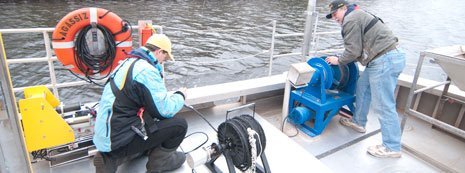Activated carbon enhanced ozonation of oxalate attributed to HO oxidation in bulk solution and surface oxidation: Effect of activated carbon dosage and pH
Document Type
Article
Publication Date
2014
Abstract
Ozonation of oxalate in aqueous phase was performed with a commercial activated carbon (AC) in this work. The effect of AC dosage and solution pH on the contribution of hydroxyl radicals (HO) in bulk solution and oxidation on the AC surface to the removal of oxalate was studied. We found that the removal of oxalate was reduced by tert-butyl alcohol (tBA) with low dosages of AC, while it was hardly affected by tBA when the AC dosage was greater than 0.3 g/L. tBA also inhibited ozone decomposition when the AC dosage was no more than 0.05 g/L, but it did not work when the AC dosage was no less than 0.1 g/L. These observations indicate that HO in bulk solution and oxidation on the AC surface both contribute to the removal of oxalate. HO oxidation in bulk solution is significant when the dosage of AC is low, whereas surface oxidation is dominant when the dosage of AC is high. The oxalate removal decreased with increasing pH of the solution with an AC dosage of 0.5 g/L. The degradation of oxalate occurs mainly through surface oxidation in acid and neutral solution, but through HO oxidation in basic bulk solution. A mechanism involving both HO oxidation in bulk solution and surface oxidation was proposed for AC enhanced ozonation of oxalate.
Publication Title
Journal of Environmental Sciences
Recommended Citation
Xang, L.,
Xie, Y.,
Minakata, D.,
Cao, H.,
Xiao, J.,
Zhang, Y.,
&
Crittenden, J. C.
(2014).
Activated carbon enhanced ozonation of oxalate attributed to HO oxidation in bulk solution and surface oxidation: Effect of activated carbon dosage and pH.
Journal of Environmental Sciences,
26(10), 2095-2105.
http://doi.org/10.1016/j.jes.2014.08.009
Retrieved from: https://digitalcommons.mtu.edu/cee-fp/7


Publisher's Statement
Copyright © 2014 Published by Elsevier B.V. Publisher's version of record: https://doi.org/10.1016/j.jes.2014.08.009